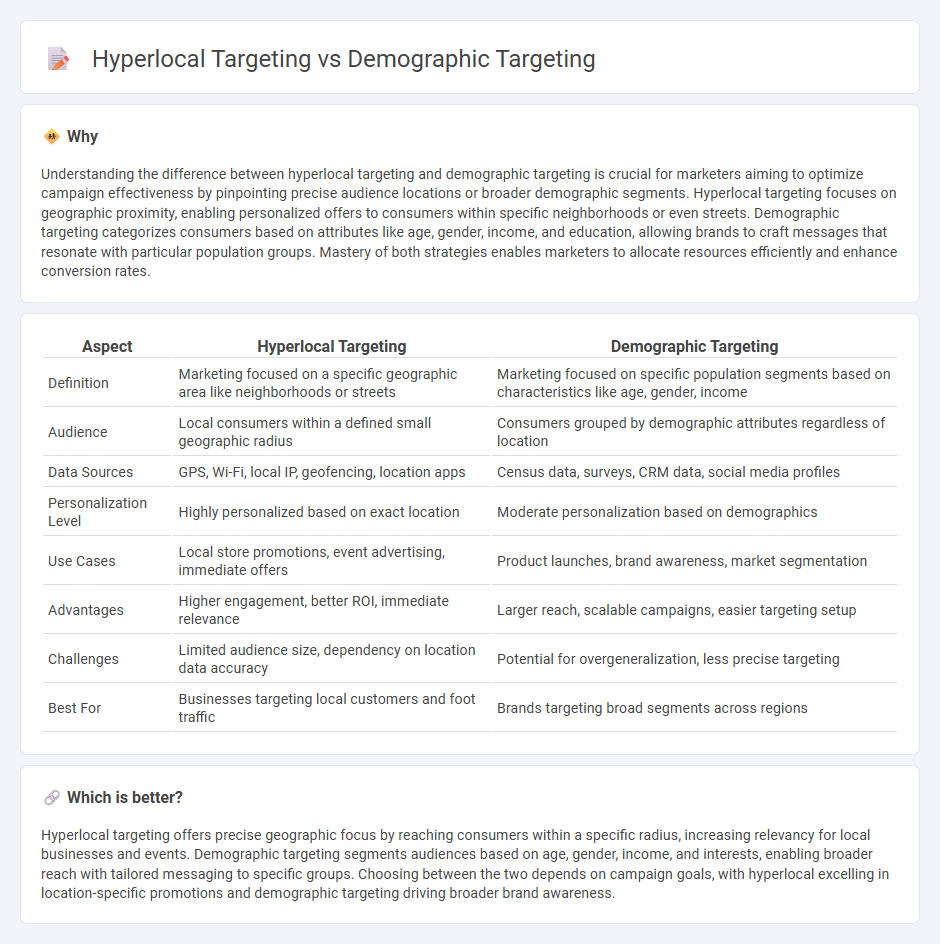
Hyperlocal targeting focuses on reaching consumers within a specific geographic area, leveraging location data to deliver personalized offers and content that resonate with local preferences and behaviors. Demographic targeting segments audiences based on characteristics such as age, gender, income, and education, allowing marketers to tailor messages to broad population groups. Discover the distinct advantages and strategies to optimize your marketing campaigns by exploring both targeting approaches in depth.
Why it is important
Understanding the difference between hyperlocal targeting and demographic targeting is crucial for marketers aiming to optimize campaign effectiveness by pinpointing precise audience locations or broader demographic segments. Hyperlocal targeting focuses on geographic proximity, enabling personalized offers to consumers within specific neighborhoods or even streets. Demographic targeting categorizes consumers based on attributes like age, gender, income, and education, allowing brands to craft messages that resonate with particular population groups. Mastery of both strategies enables marketers to allocate resources efficiently and enhance conversion rates.
Comparison Table
| Aspect | Hyperlocal Targeting | Demographic Targeting |
|---|---|---|
| Definition | Marketing focused on a specific geographic area like neighborhoods or streets | Marketing focused on specific population segments based on characteristics like age, gender, income |
| Audience | Local consumers within a defined small geographic radius | Consumers grouped by demographic attributes regardless of location |
| Data Sources | GPS, Wi-Fi, local IP, geofencing, location apps | Census data, surveys, CRM data, social media profiles |
| Personalization Level | Highly personalized based on exact location | Moderate personalization based on demographics |
| Use Cases | Local store promotions, event advertising, immediate offers | Product launches, brand awareness, market segmentation |
| Advantages | Higher engagement, better ROI, immediate relevance | Larger reach, scalable campaigns, easier targeting setup |
| Challenges | Limited audience size, dependency on location data accuracy | Potential for overgeneralization, less precise targeting |
| Best For | Businesses targeting local customers and foot traffic | Brands targeting broad segments across regions |
Which is better?
Hyperlocal targeting offers precise geographic focus by reaching consumers within a specific radius, increasing relevancy for local businesses and events. Demographic targeting segments audiences based on age, gender, income, and interests, enabling broader reach with tailored messaging to specific groups. Choosing between the two depends on campaign goals, with hyperlocal excelling in location-specific promotions and demographic targeting driving broader brand awareness.
Connection
Hyperlocal targeting and demographic targeting are connected through their shared focus on delivering personalized marketing content to specific audience segments based on location and demographic data such as age, income, or interests. Combining these strategies enhances campaign precision by aligning localized offers with the relevant consumer profiles most likely to engage. This integration maximizes ROI by minimizing ad waste and improving customer relevance in targeted geographic areas.
Key Terms
Demographic Targeting:
Demographic targeting focuses on reaching audiences based on specific characteristics such as age, gender, income, education, and occupation, enabling marketers to tailor messages to distinct consumer segments. This strategy leverages data from sources like surveys, social media profiles, and purchasing behavior to optimize ad relevance and improve conversion rates. Explore how demographic targeting can enhance your marketing strategy and drive better ROI.
Age
Demographic targeting focuses on age groups by categorizing audiences into broad segments such as Gen Z, millennials, Gen X, and baby boomers, allowing marketers to tailor messages based on life stage, interests, and behaviors prevalent in each cohort. Hyperlocal targeting, on the other hand, zooms in on specific neighborhoods or even street-level locations to deliver age-relevant ads that resonate with the local culture and community dynamics. Discover how combining these approaches can enhance your advertising precision and engagement.
Gender
Demographic targeting focuses on segmenting audiences based on attributes like gender, age, income, and education to tailor marketing efforts, while hyperlocal targeting targets consumers based on specific geographic locations, such as neighborhoods or postal codes. Gender-specific campaigns in demographic targeting allow brands to customize messages and products directly appealing to male, female, or non-binary audiences, enhancing engagement and conversion rates. Explore more about optimizing marketing strategies by balancing demographic and hyperlocal targeting for precise gender-focused outreach.
Source and External Links
What is Demographic Targeting? - SimpleTiger - Demographic targeting tailors marketing efforts to specific groups based on characteristics like age, gender, income, and education to create relevant and personalized campaigns that resonate with the audience.
Demographic targeting: Your key to personalized marketing success - Demographic targeting categorizes and targets audience segments by age, gender, income, and education to improve engagement, optimize resources, and increase conversions through precise audience segmentation and data insights.
Demographic targeting - Wikipedia - Demographic targeting is behavioral advertising that uses consumer demographic information from sources like browser history and past searches to segment audiences and deliver ads to the most profitable groups.
 dowidth.com
dowidth.com